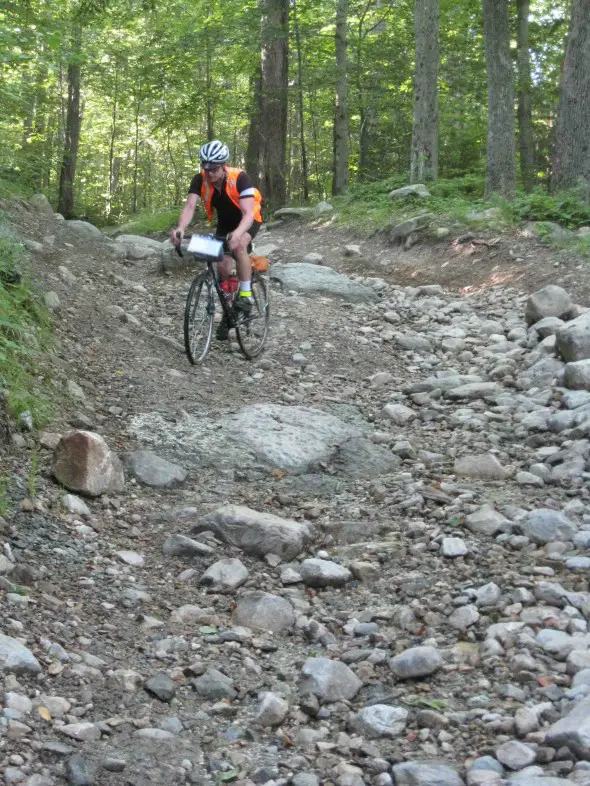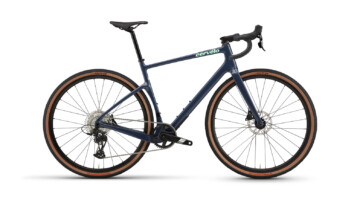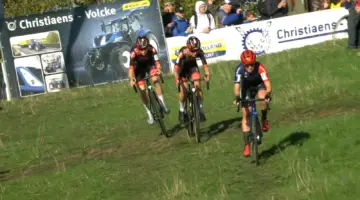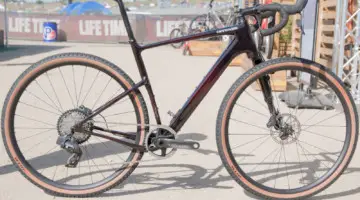Gravel racing is getting more and more popular with the cyclocross community this season. Cyclocross star Justin Lindine has won two of the big name races, the Barry Roubaix and Paris to Ancaster, and racers like Jonathan Page have been lining up to race on knobbies in the offseason. Bike like the Kona Rove are making their debut as cyclocross/gravel bikes, and Challenge has come out with two treads specifically designed to race or ride on gravel, the Almanzo and the Strada Bianca, previously named the Eroica. We’ve offered a taste of our Issue 20 Gravel Feature on the web before, but today we’re bringing you a few tips and tricks that our gravel expert Niall Gengler had to offer about what makes a gravel bike perfect.
by Niall Gengler
Dirt road riding and gravel racing is nothing new—it is, after all, the terrain that cycling started on in the first place. It also happens to be my favorite type of riding: a hard to define beast that has elements of many different genres of cycling. That said, dirt road riding and cyclocross share a lot of the same aspects, which is why I think you’re going to have a blast if you head out on your nearest dirt. Try and find your closest gravel event and get ready to get hooked. You’re bound to have fun and a hell of an adventure, see some beautiful sites and get some great training for your ’cross season.
The first thing to keep in mind is that what I’ve experienced in New England isn’t necessarily what somebody is going to go through in a Midwest or West Coast event.
The demands of each environment are slightly different—some gravel rides are well-graded and almost like paved roads, others have sections that you’d be happy to have a long-travel mountain rig for—so asking around and doing some experiments before going on a big ride is key.
As with ’Cross, the Right Tires are Key
For many gravel rides, your cyclocross tires will work just fine—and in some gnarlier courses, will be necessary—but often that’s just more knob than necessary. That said, there are basically three categories of dirt-road tires. The first are the light-weight, supple- casing performance tires like the Panaracer Pasela or Challenge Parigi-Roubaix: you’re going to feel fast, they’re going to corner really well because they’re flexible tires, but they’re also going to be very prone to flats. I’ve tested a pair of Paselas on a four-day gravel tour that included the D2R2 loop. By the time I got back, I had gotten 14 flats and multiple tears in the sidewalls; it was a miracle the tire even made it back, it had so many tears in it. If you’re going to go the lightweight route, you have to realize that philosophy is great, but only if all the stars align (and you’re on well-groomed gravel). Everything has to go your way, and in a lot of dirt situations, it’s not going to turn out like that. If you’re 10 hours into a 20-hour event, you’re not going to want to stop and fix a flat every 15 miles.
Most people run between a 28 and a 32c, though larger sizes are normal in tougher conditions. Some of the randonneur guys are running 650b wheels with a really big—40- 44c—tire to keep the same effective diameter, but with the added cushion and shock absorption. Some people swear by that. (See Issue 20 for more tire options and reviews.)
The Bike—’Cross Works Fine, but What About a Gravel-Specific Rig?
There’s an explosion in the popularity of the dirt road ride, and so much of it is in expe- riencing these beautiful roads, being really isolated and not dealing with cars. There’s this great blend between road and mountain biking and it’s an incredible adventure. The popularity is mainly coming from two different rider segments—the cyclocrossers who are realizing, “Hey, I can do this and do it well,” and those from the more traditional randonneuring background. What’s neat to see is the way these traditions can be overlapped to create the ideal “gravel bike.”
Fortunately, a ’cross bike is very close to ideal, and many are ready to go “as is” for a majority of the gravel events out there. ’Cross bikes have good tire clearance and can handle rough terrain: two necessary ingredients for a proper gravel bike.
Bottom Bracket height and center of gravity: Though many builders are lowering them, most ’cross bikes still have a relative-to-road high bottom bracket height to give pedaling clearance for hard cornering and clearing obstacles. My favorite ’cross geometry has a high 66mm of drop. A rando bike is the opposite, similar to a touring bike, usually with 70-75mm of BB drop when using 700c wheels. This gives a lower center of gravity and great stability.
Front End Geometry: Many traditional randonneurring bikes have the handling optimized for carrying a large handlebar bag. Carrying such a load on a standard ’cross bike with mid-trail, however, can make for very unstable handling.
Chainstay Length: Short chainstays reduce the wheelbase, increase cornering agility and can increase the stiffness of a frame. Long chain-stays increase stability, shock absorption and clearance for wider tires and fender options. I like the feeling of relatively short chainstays but also like to add a few millimeters from what I run for ’cross to increase my ability to run wide tires and fenders at the same time.
Bonus Tips:
Keep your butt happy: A Brooks or Selle Anatomica saddle may weigh more, but you’ve got to take comfort into the equation. If you reach a point in your ride and your racing saddle is making it so you have to stand up every couple seconds, you’re not going to go as fast as if you’re running a heavier saddle but are comfortable for the entire ride. Unless you enjoy saddle sores, don’t forget the chamois cream!
Know how to hydrate: If you don’t have water-bottle mounts, then you’ve got a bit more work to do. If it’s a steel frame, you can take it to a frame builder and add mounts. Regardless, you’re going to want at least two, if not three, bottles on the bike, and for really long unsupported rides, you may need another bottle stashed elsewhere. Camelbaks work but reduce your ability to sweat out of your back and stay cool in the heat.
Plan for everything: You’re not supported, there are no stores, and rarely does a car pass. If you can’t fix your stuff, you’re stuck out there for a while.
Watch your brakes: Whether you’re running discs or cantis, epic rides with long descents on gravel roads will eat up your brakes, especially in inclement weather. You may not need to replace your pads in one ride, but having some on hand is a good idea.
Know your route: Learn how to read your maps and cue sheet. Figure out how to hold it on your handlebars. GPS is great, but it can fail—have your maps with you. That being said: the more you get lost, the more adventure—and possibly more fun—you’re going to have. Keep a positive attitude, and don’t panic.
Be prepared to get gnarly: same as ’cross, there are those coming to the game with roadie backgrounds and those with mountain bike skills. Roadie endurance and the ability to climb well will pay off for anybody, but keep in mind that if you have the skills, being fast and comfortable at descending can pay off big too. If you are going to push the technical envelope, just keep in mind if it’s an open course, cars can come around blind corners at any time. Be respectful of other rider’s safety when bombing descents.




























